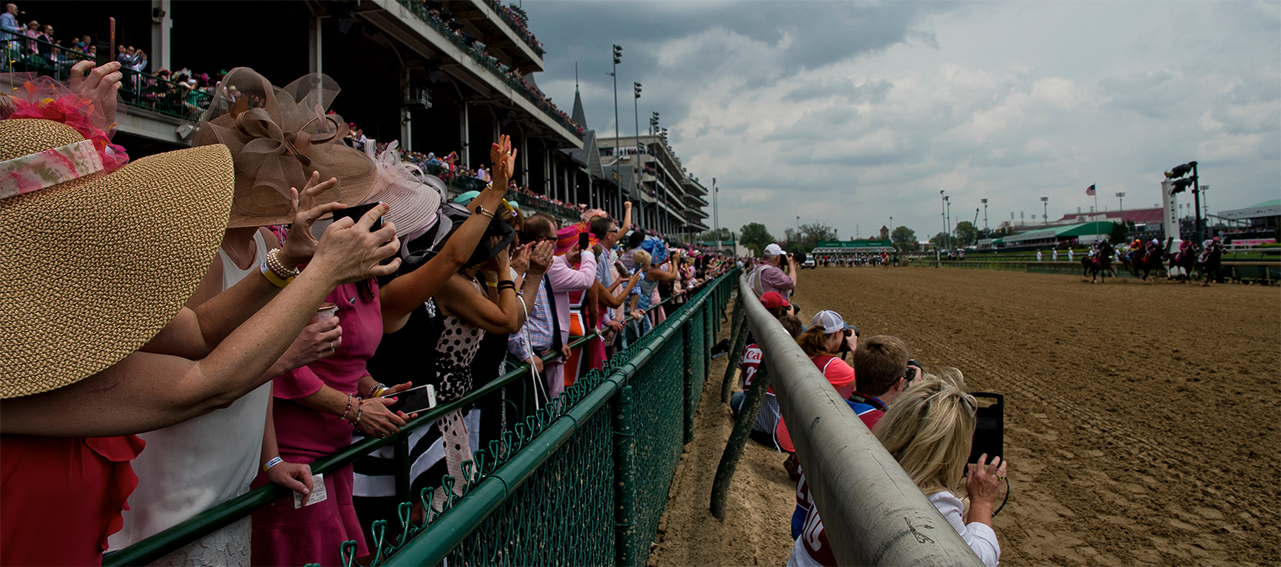I love the roar of the crowd on a big race day as much as anyone. There is nothing like it in all of sports.
Just watch the replays of American Pharoah’s triumphant run into the record books in the 2015 Belmont Stakes or Justify’s Belmont victory three years later when those special horses became the 12th and 13th Triple Crown winners, respectively. The whistles, whoops, and cheers of jubilant fans intensified as those champions accelerated around the far turn and powered through the stretch, building to a crescendo when history was secured at the wire. The type of emotion evoked from those moments on the track raises our spirits and demonstrate that horse racing is more than just a sport or a distraction from everyday life. It is a majestic metaphor for connection.
American Pharoah’s 2015 Belmont S.
Justify’s 2018 Belmont S.
To fill the void created by an absence of sports, even though we have thankfully had horse racing on a limited scale and without fans in attendance most days during the last seven weeks, television networks, websites, and sports leagues have replaced live sporting events by streaming replays of classic games, documentaries, as well as talk shows with interviews conducted over Zoom. Perhaps, they will hold us over for a time, giving us something to text our friends about while we reminisce, but racing fans and industry stakeholders at all levels of the horse business are social animals. The connections we have with the horses, with fellow fans, and even with the venues that many of us hold dear—Saratoga, Keeneland, Del Mar, and many others—simply cannot be replaced.
While I have seriously missed the roars of the crowd, the silence we have witnessed on the sports landscape reminds me of my experience covering Zenyatta’s final race. In my nearly 30 years in the Thoroughbred industry, I have reported on each of the Triple Crown races multiple times, numerous Breeders’ Cups, and signature state-bred festival days across the country. Yet, the race that stands out the most to me was the 2010 Breeders’ Cup Classic when Zenyatta’s defense of her Classic crown ended in defeat.

I will never forget the silence that fell over the crowd when Zenyatta’s stirring stretch run from last place under the lights at Churchill Downs fell just a head shy of victory in front of a crowd of 72,739 fans. The screams of encouragement from a packed grandstand turned to a hush the moment Blame hit the wire just ahead of Zenyatta, denying the even-money fan-favorite her 20th consecutive win. That memorable race was one of the most thrilling and compelling races I have ever witnessed.
The uncertain times we are facing also brings to mind a bit of nostalgia. There was a time when horse racing’s widespread interest brought immeasurable enjoyment to a generation of spectators. The historic 1938 match race between Seabiscuit and War Admiral at Pimlico, known as “The Race that Stopped a Nation,” took the minds of Americans off the Great Depression, the stock market struggles, and impending war. It was one of the most highly anticipated sporting events of the 20th century.
More than 40,000 people packed into Pimlico while an estimated 40 million people tuned in on the radio, including Franklin Roosevelt, President of the United States. Roosevelt reportedly stopped a cabinet meeting at the White House to listen to the call of the race. Seabiscuit beat War Admiral, the 1937 Triple Crown winner, by four lengths, becoming a top newsmaker of the day.
Secretariat’s 1973 Belmont S.
Seabiscuit and War Admiral’s 1938 match race
When Secretariat won the Triple Crown in jaw-dropping fashion in 1973, he captured the imagination of racing fans everywhere. It was estimated that more than 100 million people watched him in five different television appearances that year. His 31-length, record-breaking romp in the Belmont Stakes is widely considered to be the greatest race of all time. So popular was Secretariat that he appeared on the cover of Time magazine, Newsweek, and Sports Illustrated. Associated Press named the legendary horse among the Top 10 Athletes of the Year.
While we have been forced to hit a pause button, one many of us never thought imaginable, the racing and the stories—the good beats, the bad beats—will return in full force one day with the vigorous participation racing fans are known for. We will get outdoors again, and the search for the next great charismatic champion will resume at some point.
Until then, the industry has an opportunity to introduce horse racing to an even wider audience, to people unable to attend sporting events, concerts, or movies. First-run motion pictures are being streamed in living rooms across the country, and thanks to TVG, Fox Sports, and NBC, so has live horse racing in recent weeks. With a collective aversion to crowds for the foreseeable future, horse racing can still position itself as Must-See TV. The sport is ready-made for television and streaming.
When all this is behind us, and we can reassemble at our favorite racetracks again, even if at first it comes with some trepidation, I hope that the Sport of Kings can come back stronger than ever. There are no sure things in horse racing, but I bet that the roars of the crowd, silenced, for now, will thunder again.

